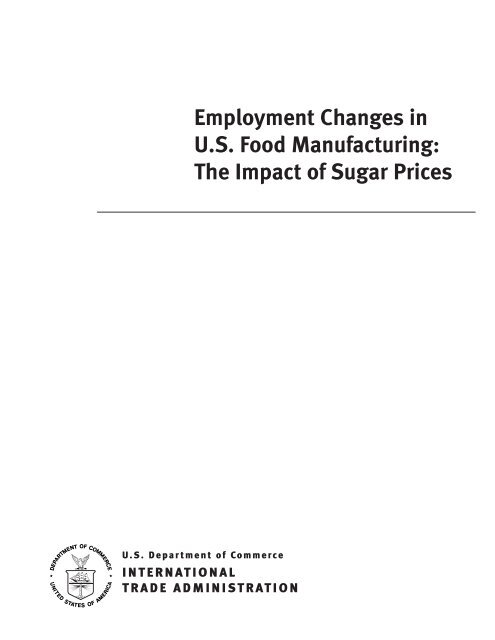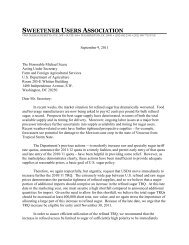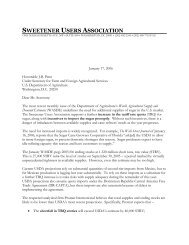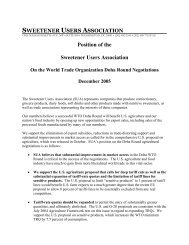Employment Changes in US Food Manufacturing - Coalition for ...
Employment Changes in US Food Manufacturing - Coalition for ...
Employment Changes in US Food Manufacturing - Coalition for ...
You also want an ePaper? Increase the reach of your titles
YUMPU automatically turns print PDFs into web optimized ePapers that Google loves.
<strong>Employment</strong> <strong>Changes</strong> <strong>in</strong><br />
U.S. <strong>Food</strong> Manufactur<strong>in</strong>g:<br />
The Impact of Sugar Prices<br />
U.S. Department of Commerce<br />
INTERNATIONAL<br />
TRADE ADMINISTRATION
The International Trade Adm<strong>in</strong>istration (ITA) has as its<br />
mission the creation of economic opportunity <strong>for</strong> U.S.<br />
workers and firms by promot<strong>in</strong>g <strong>in</strong>ternational trade,<br />
open<strong>in</strong>g <strong>for</strong>eign markets, ensur<strong>in</strong>g compliance with trade<br />
laws and agreements, and support<strong>in</strong>g U.S. commercial<br />
<strong>in</strong>terests at home and abroad. To learn more about<br />
the ITA, write to: International Trade Adm<strong>in</strong>istration,<br />
Office of Public Affairs, U.S. Department of Commerce,<br />
Wash<strong>in</strong>gton, DC 20230, or visit the ITA’s Internet site at<br />
www.ita.doc.gov.
Table of Contents<br />
Key F<strong>in</strong>d<strong>in</strong>gs................................................................................................... 2<br />
Acknowledgements......................................................................................... 2<br />
Executive Summary........................................................................................ 3<br />
Study Overview .............................................................................................. 4<br />
U.S. Sugar Prices Are Nearly Twice World Levels ....................................... 5<br />
Sugar Is Critical <strong>for</strong> Breakfast Cereal and Confectionery Products............... 5<br />
Sugar Conta<strong>in</strong><strong>in</strong>g Product Industries Experience <strong>Employment</strong> Losses ......... 6<br />
Increased SCP Imports Reflect Displaced Domestic Production................... 9<br />
Cane Ref<strong>in</strong>ers Also Faced with <strong>Employment</strong> Losses................................... 10<br />
High U.S. Sugar Prices Have Economy-Wide Implications ........................ 11<br />
Look<strong>in</strong>g Ahead.............................................................................................. 12<br />
References..................................................................................................... 12<br />
Endnotes........................................................................................................ 14<br />
<strong>Employment</strong> <strong>Changes</strong> <strong>in</strong> U.S. <strong>Food</strong> Manufactur<strong>in</strong>g: The Impact of Sugar Prices 1
Key F<strong>in</strong>d<strong>in</strong>gs<br />
1. <strong>Employment</strong> <strong>in</strong> sugar conta<strong>in</strong><strong>in</strong>g products (SCPs) <strong>in</strong>dustries decreased by more<br />
than 10,000 jobs between 1997 and 2002 accord<strong>in</strong>g to the Bureau of Labor<br />
Statistics.<br />
2. For each one sugar grow<strong>in</strong>g and harvest<strong>in</strong>g job saved through high U.S. sugar<br />
prices, nearly three confectionery manufactur<strong>in</strong>g jobs are lost.<br />
3. For the confectionery <strong>in</strong>dustry <strong>in</strong> particular, evidence suggests that sugar costs<br />
are a major factor <strong>in</strong> relocation decisions because high U.S. sugar prices<br />
represent a larger share of total production costs than labor. In 2004, the price<br />
of U.S ref<strong>in</strong>ed sugar was 23.5 cents per pound compared to the world price at<br />
10.9 cents.<br />
4. Many U.S. SCP manufacturers have closed or relocated to Canada where sugar<br />
prices are less than half of U.S. prices and to Mexico where sugar prices are<br />
about two-thirds of U.S. prices.<br />
5. Imports of SCPs have grown rapidly from $6.7 billion <strong>in</strong> 1990, to $10.2 billion <strong>in</strong><br />
1997, up to $18.7 billion <strong>in</strong> 2004.<br />
Acknowledgements<br />
The follow<strong>in</strong>g organizations and <strong>in</strong>dividuals contributed their time and expertise <strong>in</strong><br />
prepar<strong>in</strong>g and review<strong>in</strong>g this study:<br />
• American Sugar Alliance<br />
• Sweetener Users Association<br />
• The National Confectioners Association<br />
• The Bureau of Economic Analysis, U.S. Department of Commerce<br />
<strong>Employment</strong> <strong>Changes</strong> <strong>in</strong> U.S. <strong>Food</strong> Manufactur<strong>in</strong>g: The Impact of Sugar Prices 2
Executive Summary<br />
The Report of the House Appropriations Committee on H.R. 4754, the Commerce,<br />
Justice, and State, the Judiciary, and related agencies appropriations bill <strong>for</strong> fiscal year<br />
2005 (H.Report 108-576) directed the Secretary of Commerce "to report on whether jobs<br />
<strong>in</strong> food manufactur<strong>in</strong>g (<strong>in</strong>clud<strong>in</strong>g confectionery), cane ref<strong>in</strong><strong>in</strong>g and related <strong>in</strong>dustries<br />
have been lost as a result of the movement of manufactur<strong>in</strong>g facilities offshore due, <strong>in</strong><br />
material part, to the differential between U.S. and world sugar prices, and if applicable,<br />
the report shall <strong>in</strong>clude an estimate of the number of jobs lost."<br />
Supply and Demand<br />
The United States used approximately 17.8 billion pounds of ref<strong>in</strong>ed sugar <strong>in</strong> 2003, down<br />
from 18.5 billion pounds <strong>in</strong> 1999. Approximately 85 percent of this sugar was produced<br />
domestically and the rema<strong>in</strong><strong>in</strong>g portion was imported. The three ma<strong>in</strong> sugar-consum<strong>in</strong>g<br />
product sectors are non-chocolate confectionery, chocolate and chocolate confectionery,<br />
and breakfast cereal.<br />
Several factors have contributed to the decl<strong>in</strong><strong>in</strong>g demand <strong>for</strong> U.S. ref<strong>in</strong>ed sugar <strong>in</strong>clud<strong>in</strong>g<br />
cost, confectionery plant clos<strong>in</strong>gs and relocations abroad, higher ref<strong>in</strong><strong>in</strong>g costs <strong>for</strong> cane<br />
versus beet sugar, greater use of other sweeteners and sugar substitutes, and <strong>in</strong>creased<br />
imports of sugar conta<strong>in</strong><strong>in</strong>g products (SCPs). Imports of SCPs have grown rapidly from<br />
$6.7 billion <strong>in</strong> 1990, to $10.2 billion <strong>in</strong> 1997, up to $18.7 billion <strong>in</strong> 2004.<br />
As U.S. sugar production cont<strong>in</strong>ues to be protected, trade <strong>in</strong> sugar conta<strong>in</strong><strong>in</strong>g products<br />
has been liberalized. The trade imbalance <strong>in</strong> SCPs <strong>in</strong>creased nearly five-fold over 1997<br />
to 2002 to $4.7 billion, while the sugar content <strong>in</strong> imported products has also risen. As a<br />
result, <strong>for</strong>eign manufacturers' access to lower-priced sugar contributes to <strong>in</strong>creased<br />
imports and h<strong>in</strong>ders U.S. manufacturers' abilities to compete both here and abroad.<br />
Price<br />
In general, the domestic price of U.S. wholesale ref<strong>in</strong>ed sugar over the last 25 years has<br />
been two to three times the world price. These higher prices are ma<strong>in</strong>ta<strong>in</strong>ed through<br />
support loans and tariff-rate quotas. In 2004, the U.S. price was 23.5 cents per pound,<br />
compared to the world price at 10.9 cents. This price differential results <strong>in</strong> a significant<br />
competitive cost disadvantage <strong>for</strong> domestic SCP manufacturers.<br />
Plant Relocations<br />
Many U.S. SCP manufacturers have closed or relocated to Canada where sugar prices<br />
average less than half of U.S. prices, and Mexico where sugar prices average about twothirds<br />
of U.S. prices. Other factors such as labor and health care costs also favor Canada<br />
<strong>Employment</strong> <strong>Changes</strong> <strong>in</strong> U.S. <strong>Food</strong> Manufactur<strong>in</strong>g: The Impact of Sugar Prices 3
and Mexico over the United States. For the confectionery <strong>in</strong>dustry <strong>in</strong> particular, sugar<br />
costs appear to be a major factor <strong>in</strong> relocation decisions because high domestic sugar<br />
prices represent a larger share of total production costs than labor.<br />
Job Losses<br />
<strong>Employment</strong> <strong>in</strong> SCP <strong>in</strong>dustries decreased by more than 10,000 jobs between 1997 and<br />
2002 accord<strong>in</strong>g to the Bureau of Labor Statistics. Dur<strong>in</strong>g the same period, non-SCP food<br />
manufactur<strong>in</strong>g employment grew by 31,326.<br />
A compilation of press reports s<strong>in</strong>ce 2000 provides anecdotal evidence that 6,400<br />
domestic confectionery jobs have been lost due to closures, restructur<strong>in</strong>g and relocations<br />
where high sugar prices were cited as a major factor. This does not account <strong>for</strong> job losses<br />
<strong>in</strong> other SCP <strong>in</strong>dustries and thus may understate the full employment effects.<br />
Approximately 987,810 people worked <strong>in</strong> sugar-us<strong>in</strong>g <strong>in</strong>dustries as of 2002. In contrast,<br />
there are 61,000 full-time equivalent jobs <strong>in</strong>volved <strong>in</strong> the grow<strong>in</strong>g and harvest<strong>in</strong>g of<br />
sugarcane and sugar beets. Studies suggest that the U.S. sugar program helps to ma<strong>in</strong>ta<strong>in</strong><br />
approximately 2,260 of these sugar <strong>in</strong>dustry jobs, many of which are grow<strong>in</strong>g and<br />
harvest<strong>in</strong>g jobs, at an annual cost per job saved of $826,000. 1<br />
In addition to the cost per job saved, nearly three confectionery manufactur<strong>in</strong>g jobs are<br />
lost <strong>for</strong> every job protected <strong>in</strong> the sugar grow<strong>in</strong>g sector due to the price gap between U.S.<br />
and world ref<strong>in</strong>ed sugar prices. These figures are rough estimates and should be viewed<br />
as illustrative of the impacts of the sugar program rather than precise po<strong>in</strong>t estimates.<br />
Study Overview<br />
The Report of the House Appropriations Committee on H.R. 4754, the Commerce,<br />
Justice, and State, the Judiciary, and related agencies appropriations bill <strong>for</strong> fiscal year<br />
2005 (H.Report 108-576) directed the Secretary of Commerce "to report on whether jobs<br />
<strong>in</strong> food manufactur<strong>in</strong>g (<strong>in</strong>clud<strong>in</strong>g confectionery), cane ref<strong>in</strong><strong>in</strong>g and related <strong>in</strong>dustries<br />
have been lost as a result of the movement of manufactur<strong>in</strong>g facilities offshore due, <strong>in</strong><br />
material part, to the differential between U.S. and world sugar prices, and if applicable,<br />
the report shall <strong>in</strong>clude an estimate of the number of jobs lost. The estimate is to be <strong>for</strong><br />
the most recent five-year period.”<br />
The Congressional request directed an exam<strong>in</strong>ation of the employment effects of food<br />
manufactur<strong>in</strong>g plant clos<strong>in</strong>gs and relocations. However, there is no official government<br />
data that systematically tracks plant clos<strong>in</strong>gs, and firms are not required to disclose the<br />
reasons beh<strong>in</strong>d such clos<strong>in</strong>gs and relocations. Similarly, workers do not report the precise<br />
reasons beh<strong>in</strong>d their employment loss. As such, it becomes extremely difficult to<br />
determ<strong>in</strong>e the actual extent of and motivations beh<strong>in</strong>d plant clos<strong>in</strong>gs.<br />
<strong>Employment</strong> <strong>Changes</strong> <strong>in</strong> U.S. <strong>Food</strong> Manufactur<strong>in</strong>g: The Impact of Sugar Prices 4
Given these circumstances, the most appropriate approach to prepare this study was to<br />
use exist<strong>in</strong>g research data. This <strong>in</strong>cludes Bureau of Labor Statistics data on employment,<br />
a comprehensive review of press reports on plant clos<strong>in</strong>gs and relocations, a comparison<br />
of recent trends between SCP and non-SCP <strong>in</strong>dustries, exist<strong>in</strong>g studies conducted by<br />
government and non-government agencies, and cost share data of sugar and other factors.<br />
This approach allowed us to determ<strong>in</strong>e the impact of U.S. sugar prices on plant clos<strong>in</strong>gs<br />
and relocations and result<strong>in</strong>g job losses.<br />
Further analysis would require an economic model that captures the <strong>in</strong>tricate l<strong>in</strong>kages<br />
between production, employment, and <strong>for</strong>eign direct <strong>in</strong>vestment of the sugar and sugarus<strong>in</strong>g<br />
sectors.<br />
U.S. Sugar Prices Are Nearly Twice World Levels<br />
Sugar is an important raw material <strong>in</strong>put <strong>for</strong> certa<strong>in</strong> food manufacturers and is the largest<br />
raw material <strong>in</strong>put <strong>for</strong> confectionery products. U.S. sugar policy, ma<strong>in</strong>ta<strong>in</strong>ed through<br />
support loans, tariff-rate quotas, and domestic supply restrictions, has contributed to the<br />
large gap between the U.S. and world sugar prices. Many other sugar-produc<strong>in</strong>g<br />
countries’ governments also <strong>in</strong>tervene <strong>in</strong> sugar markets, which has contributed to<br />
overproduction and depressed world prices. 2<br />
Over the last 25 years, the U.S. price of wholesale ref<strong>in</strong>ed sugar has on average been two<br />
to three times the world price, and <strong>in</strong> 2004, the world ref<strong>in</strong>ed price was 10.9 cents per<br />
pound compared to the U.S. price of 23.5 cents per pound. U.S. food manufacturers pay<br />
a significantly higher price than many of their <strong>for</strong>eign competitors, currently more than<br />
double, which puts them at a competitive cost disadvantage.<br />
Sugar Is Critical <strong>for</strong> Breakfast Cereal and Confectionery Products<br />
One determ<strong>in</strong>ant of how sugar prices may affect the food manufactur<strong>in</strong>g <strong>in</strong>dustry is the<br />
extent of sugar used as raw material <strong>in</strong> the production process. To get a sense of the<br />
products <strong>for</strong> which sugar is especially important, we calculated the cost share of sugar as<br />
a percentage of total material <strong>in</strong>puts on a value basis from 2002 Census data. The cost<br />
share is obta<strong>in</strong>ed by divid<strong>in</strong>g the cost of sugar used as a material <strong>in</strong>put by the cost of all<br />
raw material <strong>in</strong>puts used <strong>in</strong> production. Our analysis <strong>in</strong>dicates that sugar represents<br />
nearly 20 to 30 percent of raw material costs <strong>for</strong> confectionery products and breakfast<br />
cereals (Table 1 lists the cost share of sugar as a raw material <strong>in</strong> 2002.) For some other<br />
products, such as breweries and flour mill<strong>in</strong>g, these costs are relatively small. The three<br />
ma<strong>in</strong> SCP sectors looked at <strong>in</strong> this study are non-chocolate confectionery, chocolate and<br />
chocolate confectionery, and breakfast cereal.<br />
<strong>Employment</strong> <strong>Changes</strong> <strong>in</strong> U.S. <strong>Food</strong> Manufactur<strong>in</strong>g: The Impact of Sugar Prices 5
Table 1: Cost Share of Sugar as a Raw Material, 2002<br />
NAICS Sugar Conta<strong>in</strong><strong>in</strong>g Product<br />
Cost Share of<br />
Sugar<br />
311230 Breakfast cereal manufactur<strong>in</strong>g 32.7%<br />
311340 Nonchocolate confectionery manufactur<strong>in</strong>g 28.1%<br />
311330 Confectionery from purchased chocolate 19.1%<br />
311320 Confectionery from cacao beans 17.7%<br />
311930 Flavor<strong>in</strong>g syrup & concentrate mfg 15.1%<br />
311990 All other food manufactur<strong>in</strong>g 14.4%<br />
311813 Frozen cakes & other pastries manuf.* 12.4%<br />
311822 Mixes & dough 8.5%<br />
311821 Cookie & cracker manufactur<strong>in</strong>g ** 8.4%<br />
31181A Bread & bakery, except frozen, manuf. 8.3%<br />
311941 Mayonnaise, dress<strong>in</strong>g, & sauce manuf. 6.0%<br />
311520 Ice cream & frozen dessert manufactur<strong>in</strong>g 4.0%<br />
311514 Dry, condensed, & evaporated dairy 2.2%<br />
311942 Spice & extract manufactur<strong>in</strong>g 2.1%<br />
311420 Canned fruits & vegetables 1.5%<br />
311511 Fluid milk manufactur<strong>in</strong>g 0.9%<br />
311410 Frozen food manufactur<strong>in</strong>g 0.5%<br />
312110 Soft dr<strong>in</strong>k & ice manufactur<strong>in</strong>g 0.5%<br />
311111 Dog & cat food manufactur<strong>in</strong>g 0.5%<br />
311211 Flour mill<strong>in</strong>g 0.4%<br />
311919 Other snack food manufactur<strong>in</strong>g 0.4%<br />
311119 Other animal food manufactur<strong>in</strong>g 0.1%<br />
312120 Breweries 0.1%<br />
Source: Economic Census, 2002<br />
Sugar Conta<strong>in</strong><strong>in</strong>g Product Industries Experience <strong>Employment</strong> Losses<br />
<strong>Employment</strong> <strong>in</strong> the SCP <strong>in</strong>dustries decreased by more than 10,000 jobs between 1997 and<br />
2002 and stood at approximately 987,810 total jobs as of 2002. 3 This is <strong>in</strong> contrast to the<br />
non-SCP food manufactur<strong>in</strong>g <strong>in</strong>dustries <strong>in</strong> which employment expanded by more than<br />
31,000 jobs. Non-chocolate confectionery, chocolate and chocolate confectionery, and<br />
breakfast cereal account <strong>for</strong> more than half of these job losses. (Table 2 highlights<br />
changes <strong>in</strong> SCP and non-SCP employment between 1997 and 2002.)<br />
The SCP job losses have occurred despite <strong>in</strong>creased domestic production. More<br />
specifically, SCP production, which accounts <strong>for</strong> more than 70 percent of all food<br />
manufactur<strong>in</strong>g, grew by 10.5 percent between 1997 to 2002 while those sectors lost<br />
10,000 jobs. Non-SCP production, <strong>in</strong> contrast, <strong>in</strong>creased by 5.2 percent and added more<br />
than 31,000 jobs over this same period.<br />
<strong>Employment</strong> <strong>Changes</strong> <strong>in</strong> U.S. <strong>Food</strong> Manufactur<strong>in</strong>g: The Impact of Sugar Prices 6
Table 2: SCP and Non-SCP <strong>Employment</strong>, 1997 and 2002<br />
<strong>Employment</strong> (actual)<br />
1997 2002<br />
Non-SCPs 452,655 483,981<br />
SCPs 997,989 987,810<br />
Source: Bureau of Labor Statistics<br />
Most of the <strong>in</strong>creases <strong>in</strong> non-SCP employment were <strong>in</strong> poultry process<strong>in</strong>g (18,517), meat<br />
process<strong>in</strong>g (8,589), and w<strong>in</strong>eries. Non-SCP employment fell <strong>in</strong> most other categories,<br />
especially dry pasta manufactur<strong>in</strong>g (2,361), coffee and tea manufactur<strong>in</strong>g (1,581), and<br />
oilseed process<strong>in</strong>g (1,112). The overall employment growth <strong>in</strong> non-SCP food<br />
manufactur<strong>in</strong>g can be attributed to expand<strong>in</strong>g export markets and <strong>in</strong>creases <strong>in</strong> the size<br />
and diversity of the American population. These demographic changes have driven<br />
consumer demand <strong>for</strong> an <strong>in</strong>creased variety of highly processed and ethnic foods. But,<br />
like all of manufactur<strong>in</strong>g, the employment growth has been muted by automation and<br />
<strong>in</strong>creas<strong>in</strong>g productivity.<br />
Sugar Prices Cited as Significant Factor <strong>in</strong> Plant Clos<strong>in</strong>gs and Relocations<br />
In spite of <strong>in</strong>creased demand and production, many domestic SCP firms are clos<strong>in</strong>g down<br />
and relocat<strong>in</strong>g operations abroad. Others are expand<strong>in</strong>g offshore rather than expand<strong>in</strong>g<br />
domestically. A comprehensive review of press reports over the past five years, where<br />
actual job loss numbers are reported, suggests that plant clos<strong>in</strong>gs and relocations abroad<br />
alone have accounted <strong>for</strong> 6,400 or nearly two-thirds of the 10,000 job losses <strong>in</strong> SCP<br />
<strong>in</strong>dustries. This is a rough approximation and likely understates the extent to which plant<br />
clos<strong>in</strong>gs and relocations account <strong>for</strong> job losses. This does not account <strong>for</strong> jobs that are<br />
created abroad <strong>in</strong>stead of domestically. Also, many of the companies report<strong>in</strong>g domestic<br />
plant clos<strong>in</strong>gs and relocations do not offer <strong>in</strong><strong>for</strong>mation on the actual number of jobs that<br />
would be affected and thus are not counted.<br />
For example, Ferrara Pan Candy reported clos<strong>in</strong>g several domestic facilities while<br />
open<strong>in</strong>g one plant <strong>in</strong> Mexico and two <strong>in</strong> Canada, result<strong>in</strong>g <strong>in</strong> a domestic employment loss<br />
of 500 jobs. 4 In addition, more than 1,000 Brach’s candy employees lost their jobs when<br />
the company closed its Chicago plant and started outsourc<strong>in</strong>g abroad. 5 Hershey <strong>Food</strong>s<br />
also closed plants <strong>in</strong> Pennsylvania, Colorado, and Cali<strong>for</strong>nia, relocat<strong>in</strong>g them to Canada,<br />
result<strong>in</strong>g <strong>in</strong> more than 1,000 job losses. 6 Access to lower-priced sugar was cited as a<br />
significant contribut<strong>in</strong>g factor <strong>in</strong> all of these relocation decisions.<br />
One large candy company recently stated that labor represents only 3 to 6 percent of the<br />
total costs to make a piece of candy, while sugar represents 30 to 70 percent. 7 Another<br />
candy company noted that it was hard to compare wages between its U.S. and Mexican<br />
plants, but the company expected to save $2 million a year by purchas<strong>in</strong>g sugar <strong>in</strong><br />
Mexico. 8 A third company noted that it uses 100,000 pounds of sugar every day and at a<br />
price differential of 12 to 16 cents a pound – that is, an added cost of $12,000 to $16,000<br />
<strong>Employment</strong> <strong>Changes</strong> <strong>in</strong> U.S. <strong>Food</strong> Manufactur<strong>in</strong>g: The Impact of Sugar Prices 7
per day. 9 This company also noted there are no alternatives to sugar <strong>in</strong> produc<strong>in</strong>g<br />
lollipops, candy canes, and other hard candies. 10<br />
Confectionery Plant Clos<strong>in</strong>gs Hit Chicago Region Especially Hard<br />
There are certa<strong>in</strong> areas of the country that have been affected significantly by SCP plant<br />
clos<strong>in</strong>gs and relocations. Chicago, one of the largest U.S. cities <strong>for</strong> confectionery<br />
manufactur<strong>in</strong>g, has lost nearly one-third of its SCP manufactur<strong>in</strong>g jobs over the last 13<br />
years. These losses are attributed, <strong>in</strong> part, to high U.S. sugar prices. The metro Chicago<br />
confectionery <strong>in</strong>dustry ma<strong>in</strong>ta<strong>in</strong>ed 8,500 jobs <strong>in</strong> 2001, down 3,642 jobs s<strong>in</strong>ce 1991<br />
represent<strong>in</strong>g a 30 percent employment decl<strong>in</strong>e. (Table 3 illustrates that Ill<strong>in</strong>ois SCP<br />
manufacturers experienced a sharper employment decl<strong>in</strong>e than overall manufactur<strong>in</strong>g <strong>in</strong><br />
that state.)<br />
Chicago sugar-user<br />
manufactur<strong>in</strong>g<br />
employment*<br />
Ill<strong>in</strong>ois sugar-user<br />
manufactur<strong>in</strong>g<br />
employment<br />
Ill<strong>in</strong>ois<br />
manufactur<strong>in</strong>g<br />
employment<br />
Table 3: SCP <strong>Employment</strong> Losses <strong>in</strong> Ill<strong>in</strong>ois, 1991 to 2001<br />
1991 2001 Absolute<br />
Change<br />
Percent<br />
Change<br />
15,068 11,000 -4,068 -27<br />
30,952 26,000 -4,952 -16<br />
875,700 815,400 -60,300 -7<br />
Source: Sources: “Federal Sugar Support Program Brief,” World Bus<strong>in</strong>ess Chicago, February 9,<br />
2004, and Bureau of Labor Statistics<br />
* Sugar-user manufacturers <strong>in</strong>clude confectionery, cereals, gum, and bakery.<br />
Industry Studies at Odds<br />
In addition to press reports, there have been two studies commissioned by <strong>in</strong>dustry. The<br />
Sweetener Users Association commissioned Promar International to conduct a study on<br />
the employment effects of the U.S. sugar program. Promar calculated that between 7,500<br />
and 10,000 jobs have been lost s<strong>in</strong>ce 1997 because of artificially high sugar prices. This<br />
estimate only counts jobs directly impacted by the price of sugar. Promar acknowledges<br />
that labor costs and other factors play a role <strong>in</strong> companies’ decisions to relocate<br />
operations outside the United States, but ma<strong>in</strong>ta<strong>in</strong>s that the cost of sugar is a major<br />
factor. 11<br />
The American Sugar Alliance commissioned Buzzanell and Associates to conduct a<br />
similar study on the confectionery <strong>in</strong>dustry. Buzzanell argues that the overrid<strong>in</strong>g reasons<br />
beh<strong>in</strong>d U.S. confectionery plant relocations from the U.S. to Mexico and Canada has<br />
<strong>Employment</strong> <strong>Changes</strong> <strong>in</strong> U.S. <strong>Food</strong> Manufactur<strong>in</strong>g: The Impact of Sugar Prices 8
een labor and related costs rather than lower sugar prices. 12 Buzzanell presents data<br />
obta<strong>in</strong>ed largely from private <strong>in</strong>terviews with confectionery companies <strong>in</strong> Mexico,<br />
Canada, and the United States (Chicago, Ill<strong>in</strong>ois and Holland, Michigan) and compares<br />
the costs of wages, health care <strong>in</strong>surance, taxes, electricity, land, and ref<strong>in</strong>ed sugar <strong>in</strong><br />
each operation.<br />
Cost comparison data are useful on a factor-by-factor basis, but say little about the<br />
importance of one cost factor relative to other factors. For example, accord<strong>in</strong>g to the<br />
2002 Economic Census, sugar accounts <strong>for</strong> 18 to 33 percent of raw material costs,<br />
compared to a 16 percent share of total costs <strong>for</strong> labor. There is no substitute <strong>for</strong> sugar<br />
<strong>for</strong> many confectionery products such as hard candies, which expla<strong>in</strong>s the relatively high<br />
cost share of sugar <strong>for</strong> these products. The lack of comparable data across all SCPs <strong>for</strong><br />
both sugar and labor costs makes it difficult to systematically exam<strong>in</strong>e the relative<br />
importance of sugar and labor, thus prevent<strong>in</strong>g any broad SCP <strong>in</strong>dustry-wide conclusions.<br />
Increased SCP Imports Reflect Displaced Domestic Production<br />
Plant clos<strong>in</strong>gs and relocations have been accompanied by <strong>in</strong>creas<strong>in</strong>g SCP imports. While<br />
NAFTA and other free trade agreements have liberalized trade <strong>in</strong> manufactured foods,<br />
sugar cont<strong>in</strong>ues to be protected. The relatively high U.S. sugar price results <strong>in</strong> cheaper<br />
SCP imports and a cost competitive disadvantage <strong>for</strong> domestic SCP producers. This is<br />
mirrored by sharp <strong>in</strong>creases <strong>in</strong> SCP imports as well as <strong>in</strong>creased sugar content <strong>in</strong> those<br />
SCP imports.<br />
Imports of SCPs have grown rapidly from $6.7 billion <strong>in</strong> 1990, to $10.2 billion <strong>in</strong> 1997,<br />
and up to $18.7 billion <strong>in</strong> 2004. Import growth <strong>in</strong> SCPs has clearly outpaced that of non-<br />
SCPs. Not only has the trade imbalance <strong>in</strong> SCPs <strong>in</strong>creased—the trade deficit <strong>in</strong> SCPs has<br />
<strong>in</strong>creased nearly five-fold s<strong>in</strong>ce 1997 to $4.7 billion <strong>in</strong> 2002, but the actual sugar content<br />
<strong>in</strong> these SCP imports has cont<strong>in</strong>ued to rise. (Figure 1 shows that SCP imports and the<br />
amount of sugar <strong>in</strong> SCP imports are on the rise.) Sugar <strong>in</strong> imported SCPs grew 111,000<br />
short tons (raw value) from FY 2003 to FY 2004 <strong>for</strong> a growth rate of 11.6 percent.<br />
Accord<strong>in</strong>g to <strong>US</strong>DA, sugar <strong>in</strong> imported products has cont<strong>in</strong>ued its growth and has<br />
displaced domestic sugar deliveries. Further, the volume of sugar imported through SCPs<br />
is <strong>in</strong>creas<strong>in</strong>g at a much higher rate than that of SCPs alone. This is illustrated through a<br />
200 percent <strong>in</strong>crease <strong>in</strong> the volume of raw sugar com<strong>in</strong>g <strong>in</strong>to the United States <strong>in</strong> these<br />
SCPs compared to a 100 percent <strong>in</strong>crease <strong>in</strong> the actual value of sugar conta<strong>in</strong><strong>in</strong>g product<br />
imports between 1993 and 2003. 13<br />
<strong>Employment</strong> <strong>Changes</strong> <strong>in</strong> U.S. <strong>Food</strong> Manufactur<strong>in</strong>g: The Impact of Sugar Prices 9
Figure 1: SCP Imports and the Amount of Sugar <strong>in</strong> SCP Imports on the Rise<br />
SCP imports <strong>in</strong> million $<br />
Share of sugar <strong>in</strong> SCP<br />
imports<br />
20,000<br />
18,000<br />
Share of sugar <strong>in</strong> SCP imports<br />
60%<br />
16,000<br />
14,000<br />
12,000<br />
SCP imports<br />
50%<br />
40%<br />
10,000<br />
30%<br />
8,000<br />
6,000<br />
20%<br />
4,000<br />
2,000<br />
10%<br />
0<br />
1993<br />
1994<br />
1995<br />
1996<br />
1997<br />
1998<br />
1999<br />
2000<br />
2001<br />
2002<br />
2003<br />
0%<br />
Source:U.S.Department of Agriculture and authors’ calculations.<br />
Sugar content is the ratio of 100 short tons raw value sugar imports to SCP imports (million $).<br />
In particular, <strong>US</strong>DA’s Economic Research Service reports that imports of confectionery<br />
and cocoa preparations have seen the most growth <strong>in</strong> sugar content. In contrast, the sugar<br />
content of domestically-produced SCPs has been decl<strong>in</strong><strong>in</strong>g. These trends reflect the<br />
displacement of domestically-produced SCPs.<br />
Cane Ref<strong>in</strong>ers Also Faced with <strong>Employment</strong> Losses<br />
The cane ref<strong>in</strong><strong>in</strong>g sector has also experienced employment losses as well as a decl<strong>in</strong>e <strong>in</strong><br />
the number of ref<strong>in</strong>eries. In 2003, there were 2,845 cane ref<strong>in</strong><strong>in</strong>g jobs, accord<strong>in</strong>g to<br />
Promar International, compared to 3,891 jobs <strong>in</strong> 1997, accord<strong>in</strong>g to Census, represent<strong>in</strong>g<br />
a loss of 1,046 jobs. The Sugar Alliance reports that there were seven rema<strong>in</strong><strong>in</strong>g<br />
ref<strong>in</strong>eries <strong>in</strong> operation as of 2005, down from 11 <strong>in</strong> 1996.<br />
Job loss <strong>in</strong> cane ref<strong>in</strong>eries is tied to the decl<strong>in</strong><strong>in</strong>g demand <strong>for</strong> ref<strong>in</strong>ed sugar <strong>for</strong> food and<br />
beverage usage, and an <strong>in</strong>crease <strong>in</strong> production costs of ref<strong>in</strong>ed cane sugar over ref<strong>in</strong>ed<br />
<strong>Employment</strong> <strong>Changes</strong> <strong>in</strong> U.S. <strong>Food</strong> Manufactur<strong>in</strong>g: The Impact of Sugar Prices 10
eet sugar <strong>in</strong> the United States. This is largely due to the price of raw sugar <strong>in</strong> the United<br />
States that is kept high as a result of the sugar price support program. This results <strong>in</strong><br />
decreased profitability <strong>for</strong> cane ref<strong>in</strong>ers. As U.S. food process<strong>in</strong>g companies relocate<br />
operations outside the United States, <strong>in</strong> order to ma<strong>in</strong>ta<strong>in</strong> global cost competitiveness,<br />
they demand less U.S. ref<strong>in</strong>ed sugar. The <strong>in</strong>creased usage of sugar substitutes—both<br />
consumer and producer driven—further reduces the dependence on ref<strong>in</strong>ed sugar. As a<br />
result, the producers and growers are consolidat<strong>in</strong>g with the ref<strong>in</strong>ers to preserve<br />
profitability. Grower-owned shares of U.S. cane ref<strong>in</strong>ed sugar sales more than<br />
quadrupled <strong>in</strong> the last five years from 14 percent of production capacity <strong>in</strong> 1999 to 57<br />
percent of production capacity <strong>in</strong> 2004. 14<br />
High U.S. Sugar Prices Have Economy-Wide Implications<br />
The economic effects of the differential between U.S. and world sugar prices are not<br />
conf<strong>in</strong>ed to employment <strong>in</strong> the SCP <strong>in</strong>dustries. The exist<strong>in</strong>g literature on the economic<br />
effects of liberalization of U.S. sugar prices suggests that elim<strong>in</strong>at<strong>in</strong>g sugar quotas and<br />
tariff rate quotas and allow<strong>in</strong>g sugar to enter the United States duty free would result <strong>in</strong><br />
economic ga<strong>in</strong>s <strong>in</strong> the <strong>for</strong>m of <strong>in</strong>creased domestic food manufactur<strong>in</strong>g production and<br />
U.S. exports, ga<strong>in</strong>s <strong>for</strong> consumers, taxpayer sav<strong>in</strong>gs, and a net positive effect on U.S.<br />
employment.<br />
The United States Department of Agriculture cites the high price of domestic sugar as a<br />
ma<strong>in</strong> factor h<strong>in</strong>der<strong>in</strong>g competitiveness of the U.S. confectionery <strong>in</strong>dustry, and notes that<br />
sales <strong>in</strong> this <strong>in</strong>dustry have shown little growth over the past couple of years. 15<br />
The Government Accountability Office estimates that economic losses to domestic<br />
sweetener users, <strong>in</strong>clud<strong>in</strong>g sugarcane ref<strong>in</strong>ers, food manufacturers, and consumers,<br />
result<strong>in</strong>g from the sugar program <strong>in</strong> 1998 were $1.9 billion due to production and<br />
consumption <strong>in</strong>efficiencies. 16 The U.S. International Trade Commission exam<strong>in</strong>ed the<br />
economic effects of the U.S. sugar program and found a net annual welfare ga<strong>in</strong> of $1<br />
billion to the U.S. economy of elim<strong>in</strong>at<strong>in</strong>g the U.S. sugar program. 17 Commission<br />
estimates reflect the total net effect <strong>for</strong> both sugar users and the sugar <strong>in</strong>dustry. 18<br />
Studies estimate that the U.S. sugar program ma<strong>in</strong>ta<strong>in</strong>s approximately 2,260 sugar<br />
harvest<strong>in</strong>g and grow<strong>in</strong>g jobs, many of which are filled by seasonal workers. The<br />
estimated annual cost per job saved is $826,000. Meanwhile, SCP <strong>in</strong>dustries have lost<br />
more than 10,000 jobs. Approximately 6,400 of these job losses can be attributed to<br />
confectionery plant clos<strong>in</strong>gs and relocations abroad, where high U.S. sugar prices were<br />
cited as a significant contribut<strong>in</strong>g factor. Together, this suggests that <strong>for</strong> each one sugar<br />
grow<strong>in</strong>g and harvest<strong>in</strong>g job saved, nearly three confectionery manufactur<strong>in</strong>g jobs are lost<br />
due to plant clos<strong>in</strong>g and relocations associated with the differential between U.S. and<br />
world sugar prices. These figures do not account <strong>for</strong> job losses <strong>in</strong> other SCP <strong>in</strong>dustries<br />
and thus may understate the job costs. However, these figures are rough estimates and<br />
should be viewed as illustrative of the impacts of the sugar program rather than precise<br />
po<strong>in</strong>t estimates.<br />
<strong>Employment</strong> <strong>Changes</strong> <strong>in</strong> U.S. <strong>Food</strong> Manufactur<strong>in</strong>g: The Impact of Sugar Prices 11
Look<strong>in</strong>g Ahead<br />
This report relies on cost share data along with comparative and trends analysis <strong>in</strong> order<br />
to assess the employment effects of food manufactur<strong>in</strong>g plant clos<strong>in</strong>gs and relocations.<br />
Press reports are also used to support the analysis. While this approach provides us with<br />
some answers <strong>for</strong> factors that might affect plant clos<strong>in</strong>g and relocations, it does not<br />
necessarily address the wide-rang<strong>in</strong>g factors that might be <strong>in</strong>volved. Further analysis<br />
would require a wider set of bus<strong>in</strong>ess <strong>in</strong><strong>for</strong>mation that firms typically take <strong>in</strong>to account <strong>in</strong><br />
mak<strong>in</strong>g such decisions, and economic models that capture the <strong>in</strong>tricate l<strong>in</strong>kages between<br />
production, employment, and <strong>for</strong>eign direct <strong>in</strong>vestment of the sugar and sugar-us<strong>in</strong>g<br />
sectors.<br />
References<br />
Barrionuevo, Alexei and Elizabeth Tucker Fewer, “Friends <strong>in</strong> High Places,” New York<br />
Times, June 2, 2005.<br />
Belsie, Laurent, “Bitter Reality: Candy Less Likely to be ‘Made <strong>in</strong> <strong>US</strong>,’” Christian<br />
Science Monitor, April 8, 2002.<br />
Boll<strong>in</strong>g, Christ<strong>in</strong>e and Agapi Somwaru, “U.S. <strong>Food</strong> Companies Access Foreign Markets<br />
through Direct Investment,” <strong>Food</strong> Review, Volume 24, Issue 3, 2001.<br />
Buzzanell, Peter, “The North American Sugar Market: Recent Trends and Prospects<br />
Beyond 2000,” <strong>for</strong> Sugar and Beverages Group, Commodities and Trade Division, FAO,<br />
1997.<br />
Boll<strong>in</strong>g, Christ<strong>in</strong>e, Steve Neff, and Charles Handy, U.S. Foreign Direct Investment <strong>in</strong> the<br />
Western Hemisphere Processed <strong>Food</strong> Industry, ERS AER-760, March 1998.<br />
Candy Bus<strong>in</strong>ess, “F<strong>in</strong>d<strong>in</strong>g the Best Right Answer,” November & December 2000.<br />
Freedman, Michael, “Sweet Stuff,” Forbes, January 10, 2005.<br />
Hufbauer, Gary Clyde and Kimberly Ann Elliott, “Measur<strong>in</strong>g the Costs of Protection <strong>in</strong><br />
the United States,” Institute <strong>for</strong> International Economics, Wash<strong>in</strong>gton, DC, January 1994.<br />
Kerr, Ann, “Quebec is Sweet to Candy Makers,” Globe and Mail, May 19, 2003.<br />
World Bus<strong>in</strong>ess Chicago, Richard M. Daley, Chairman and Paul O’Connor, Executive<br />
Director, “Federal Sugar Support Program Brief,” February 9, 2004.<br />
<strong>Employment</strong> <strong>Changes</strong> <strong>in</strong> U.S. <strong>Food</strong> Manufactur<strong>in</strong>g: The Impact of Sugar Prices 12
Promar International, “Consumers Benefit From Competitive Sugar Prices,” November<br />
2004.<br />
Peter Buzzanell & Associates, “North America’s Confectionery Industries: Structure,<br />
Trade, and Costs and Trends <strong>in</strong> Sugar Demand,” March 24, 2003.<br />
Promar International, “<strong>Food</strong> and Beverage Jobs Disappear<strong>in</strong>g Due to Sugar Program,”<br />
December 2003.<br />
Schmelter, John, “Sugar prices may cost Chicago Candy crown,” Chicago Tribune, June<br />
15, 2005<br />
U.S. Department of Agriculture, Economics Research Service, Sugar and Sweeteners<br />
Outlook <strong>for</strong> various years.<br />
U.S. Department of Agriculture, “U.S. Market Profile <strong>for</strong> Confectionery Products,”<br />
October 29, 2004.<br />
U.S. Department of Agriculture, “World Sugar Policy Review,” January 31, 2003.<br />
U.S. Department of Labor, Bureau of Labor Statistics, Career Guide to Industries 2004-<br />
2005.<br />
U.S. General Accountability Office, “Sugar Program: Support<strong>in</strong>g Sugar Prices Has<br />
Increased Users’ Costs While Benefit<strong>in</strong>g Producers,” June 2000.<br />
U.S. International Trade Commission, “The Economic Effects of Significant U.S. Import<br />
Restra<strong>in</strong>ts: Fourth Update 2004,” Inv. No. 332-325, Publication 3701, June 2004.<br />
<strong>Employment</strong> <strong>Changes</strong> <strong>in</strong> U.S. <strong>Food</strong> Manufactur<strong>in</strong>g: The Impact of Sugar Prices 13
Endnotes<br />
1<br />
2<br />
3<br />
4<br />
5<br />
6<br />
7<br />
8<br />
9<br />
10<br />
11<br />
12<br />
13<br />
14<br />
15<br />
16<br />
17<br />
18<br />
Gary Clyde Hufbauer and Kimberly Ann Elliott, “Measur<strong>in</strong>g the Costs of Protection <strong>in</strong> the United<br />
States,” Institute <strong>for</strong> International Economics, Wash<strong>in</strong>gton, DC, January 1994; and “Fruits of Free<br />
Trade,” Annual Report 2002, Federal Reserve Bank of Dallas. These estimates are based on data from<br />
the early 1990s when the differential between U.S. and world sugar prices was between 60 and 105<br />
percent. In 2004, the price differential was 116 percent. Thus, these studies likely underestimate the<br />
cost per job saved of the sugar program today.<br />
For a discussion on the global sugar market and government policies, see “World Sugar Policy<br />
Review,” U.S. Department of Agriculture, 2003.<br />
For an explanation of how the term “sugar conta<strong>in</strong><strong>in</strong>g products” is def<strong>in</strong>ed, see Box 1.<br />
Alexei Barrionuevo and Elizabeth Becker, “Fewer Friends <strong>in</strong> High Places <strong>for</strong> This Lobby,” New York<br />
Times, June 2, 2005.<br />
John Schmeltzer, “Candymaker Exits a Bitter Old Trend,” Chicago Tribune, January 1, 2004; Laurent<br />
Belsie, “Bitter Reality: Candy Less Likely to be ‘Made <strong>in</strong> <strong>US</strong>,” Christian Science Monitor, April 8,<br />
2002.<br />
Jill Jusko, “Bitter Goodbye,” Industry Week, July 1, 2002; “Trend Towards Outsourc<strong>in</strong>g Confectionery<br />
Production Grows,” Confectioner News, October 29, 2002; "Hershey Canada Unveils Expanded Moirs<br />
Plant,” Canada News Wire Group, October 14, 2003; "Wheat Ridge Jolly Rancher Plant to Close,"<br />
Denver Bus<strong>in</strong>ess Journal, October 26, 2001; "Hershey Closes Three Plants; No Cuts <strong>in</strong> Memphis,"<br />
Memphis Bus<strong>in</strong>ess Journal, October 24, 2001; "Hershey Canada Inc. Expands Plant <strong>in</strong> Dartmouth,<br />
Nova Scotia to Feed Grow<strong>in</strong>g International Demand," International Trade Canada, March 2, 2005.<br />
Alexei Barrionuevo and Elizabeth Tucker, “Fewer Friends <strong>in</strong> High Places,” New York Times, June 2,<br />
2005.<br />
Laurent Belsie, “Bitter Reality: Candy Less Likely to be ‘Made <strong>in</strong> <strong>US</strong>,” Christian Science Monitor,<br />
April 8, 2002.<br />
“F<strong>in</strong>d<strong>in</strong>g the Best Right Answer,” Candy Bus<strong>in</strong>ess, Nov./Dec. 2000.<br />
John Schmelter, “Sugar prices may cost Chicago Candy crown,” Chicago Tribune, June 15, 2005.<br />
Promar International <strong>for</strong> the Sweetener Users Association, “<strong>Food</strong> and Beverage Jobs Disappear<strong>in</strong>g Due<br />
to Sugar Program,” December 2003.<br />
Peter Buzzanell & Associates, <strong>for</strong> the American Sugar Alliance, “North America’s Confectionery<br />
Industries: Structure, Trade, and Costs and Trends <strong>in</strong> Sugar Demand,” March 24, 2003.<br />
<strong>US</strong>DA, Sugar and Sweeteners Outlook, May 31, 2005.<br />
Production capacity estimates from McKeany-Favell Company, Inc, American Sugar Alliance,<br />
October 2004.<br />
“U.S. Market Profile <strong>for</strong> Confectionery Products,” October 29, 2004, Commodity and Market<strong>in</strong>g<br />
Programs-AgExport Services Division, International Strategic Market<strong>in</strong>g Group, <strong>US</strong>DA.<br />
“Sugar Program, Support<strong>in</strong>g Sugar Prices Has Increased Users Costs While Benefit<strong>in</strong>g Producers,”<br />
United States General Account<strong>in</strong>g Office, Report to Congressional Requesters, June 2000.<br />
“The Economic Effects of Significant U.S. Import Restra<strong>in</strong>ts,” Fourth Update 2004, Investigation No.<br />
332-325, Publication 3701, United States International Trade Commission, June 2004.<br />
In addition, the Federal Reserve reported that the annual cost per sugar job (grow<strong>in</strong>g and harvest<strong>in</strong>g)<br />
that is saved is $826,104. At 2,261 sugar jobs saved, the total economic cost to the U.S. economy is<br />
$1.9 billion per year. A small number of sugar growers benefit from this and receive an estimated<br />
$400 million annually.<br />
<strong>Employment</strong> <strong>Changes</strong> <strong>in</strong> U.S. <strong>Food</strong> Manufactur<strong>in</strong>g: The Impact of Sugar Prices 14













